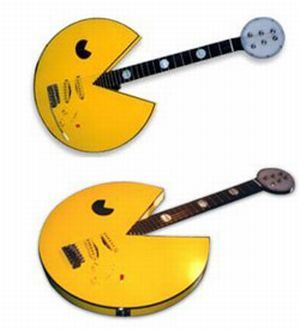|
|
Unusual Guitar
|
• General
Guitars can be constructed to meet the demands of both left and right-handed players. Traditionally the dominant hand is assigned the task of plucking or strumming the strings. For the majority of people this entails using the right hand. This is because musical expression (dynamics, tonal expression, color, etc.) is largely determined by the plucking hand, while the fretting hand is assigned the lesser mechanical task of depressing and gripping the strings. This is similar to the convention of the violin family of instruments where the right hand controls the bow. Left-handed players generally choose a left-handed (mirror) instrument, although some play in a standard right-handed manner, others play a standard right-handed guitar reversed, and still others (for example Jimi Hendrix) play a right-handed guitar strung in reverse. This last configuration differs from a true left-handed guitar in that the saddle is normally angled in such a way that the bass strings are slightly longer than the treble strings to improve intonation. Reversing the strings therefore reverses the relative orientation of the saddle (negatively affecting intonation), although in Hendrix' case this is believed to have been an important element in his unique sound.
• Headstock
The headstock is located at the end of the guitar neck furthest from the body. It is fitted with machine heads that adjust the tension of the strings, which in turn affects the pitch. Traditional tuner layout is "3+3" in which each side of the headstock has three tuners (such as on Gibson Les Pauls). In this layout, the headstocks are commonly symmetrical. Many guitars feature other layouts as well, including six-in-line (featured on Fender Stratocasters) tuners or even "4+2" (Ernie Ball Music Man). However, some guitars (such as Steinbergers) do not have headstocks at all, in which case the tuning machines are located elsewhere, either on the body or the bridge.
|
|









